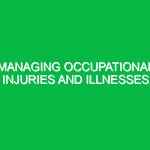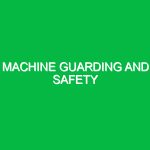In the world of manufacturing, safety is not just a regulatory requirement; it’s a fundamental aspect of corporate culture and a vital component of operational efficiency. Safety in manufacturing encompasses a broad range of practices and protocols designed to protect workers, the environment, and the overall integrity of the production process. This article will delve into the complexities of safety in manufacturing, highlighting potential hazards, safety precautions, and the regulations that guide these practices within the Health, Safety, and Environment (HSE) domain.
Understanding Safety in Manufacturing
Safety in manufacturing refers to the measures taken to prevent accidents, injuries, and illnesses in the workplace. It is an integral part of the HSE framework, which promotes a safe and healthy work environment while minimizing adverse effects on the environment. Manufacturing environments often involve heavy machinery, hazardous materials, and intricate processes that can pose significant risks. As such, a robust safety culture is essential for protecting employees and ensuring the sustainability of operations.
Consider a scenario from a mid-sized automotive plant. One day, a worker named John noticed a colleague operating a welding machine without the appropriate protective gear. John immediately intervened, reminding his coworker about the safety protocols in place. This simple act not only prevented a potential injury but also reinforced the importance of vigilance and adherence to safety standards among the workforce. Such individual actions contribute to a broader safety culture where employees feel responsible for their own safety and that of their coworkers.
Identifying Hazards and Risks in Manufacturing
Understanding the potential hazards and risks associated with manufacturing is crucial for effective safety management. Here are some of the most common hazards found in the manufacturing sector:
1. Physical Hazards
Physical hazards include any environmental factors that can cause harm to workers. These may involve:
- Machinery Injuries: Equipment such as conveyors, presses, and forklifts can lead to severe injuries if not operated safely.
- Slips, Trips, and Falls: Wet floors, uneven surfaces, and cluttered walkways pose a risk of falls, one of the leading causes of workplace injuries.
- Noise Exposure: Prolonged exposure to high levels of noise can result in hearing loss and other health issues.
2. Chemical Hazards
Manufacturing often involves chemicals that can be harmful to health. The risks include:
- Exposure to Toxic Substances: Chemicals such as solvents, acids, and heavy metals can cause immediate or long-term health issues.
- Flammable Materials: The presence of flammable liquids and gases can lead to fires and explosions if not handled properly.
3. Ergonomic Hazards
Many manufacturing jobs require repetitive movements or heavy lifting, leading to:
- Musculoskeletal Disorders: Poorly designed workstations can cause strains and injuries to muscles, ligaments, and joints.
4. Biological Hazards
In certain manufacturing environments, biological hazards can also pose risks:
- Exposure to Bacteria and Viruses: Especially relevant in food manufacturing or healthcare-related production.
Implementing Safety Precautions and Best Practices
Addressing these hazards requires a comprehensive approach to safety. Here are some actionable safety precautions and best practices that can be implemented:
1. Regular Risk Assessments
Conducting regular risk assessments is essential for identifying potential hazards. This involves evaluating work processes, equipment, and the work environment to determine risks and necessary controls. Engaging employees in these assessments can also provide valuable insights into potential dangers they face daily.
2. Training and Education
Providing thorough training for employees on safety protocols is critical. This includes:
- Regular workshops on the proper use of machinery and personal protective equipment (PPE).
- Emergency response training to prepare workers for various scenarios, such as chemical spills or fire outbreaks.
3. Personal Protective Equipment (PPE)
Ensuring that workers have access to and use appropriate PPE is vital. PPE may include hard hats, gloves, eye protection, respirators, and hearing protection. It is essential to regularly inspect and maintain PPE to ensure its effectiveness.
4. Safety Signage and Communication
Clear and visible safety signage throughout the workplace helps remind employees of hazards and safe practices. Regular safety meetings and open communication channels encourage employees to report unsafe conditions without fear of retaliation.
5. Safe Machinery Operation
Implementing strict protocols around machinery operation can prevent accidents. This includes:
- Lockout/Tagout (LOTO) procedures to ensure machines are properly shut down during maintenance.
- Regular maintenance checks to keep equipment in safe working condition.
6. Ergonomic Assessments
To address ergonomic hazards, consider conducting ergonomic assessments of workstations. This can help identify adjustments that can reduce the risk of musculoskeletal injuries, such as using adjustable chairs, proper lifting techniques, and ergonomic tools.
Regulations and Standards Governing Safety in Manufacturing
Numerous regulations and standards govern safety in manufacturing, ensuring that companies adhere to best practices and protect their employees. Key regulations include:
1. Occupational Safety and Health Administration (OSHA)
In the United States, OSHA sets and enforces standards for workplace safety. Employers are required to provide a safe workplace free from recognized hazards. OSHA also mandates training and safety programs tailored to specific industries.
2. Environmental Protection Agency (EPA)
The EPA regulates the management of hazardous waste and the emissions of pollutants into the environment. Manufacturing facilities must comply with these regulations to minimize environmental impact.
3. ISO Standards
The International Organization for Standardization (ISO) provides guidelines and standards for safety management systems (such as ISO 45001). Adopting these standards helps organizations establish a framework for improving safety and health management.
The Importance of a Safety Culture in Manufacturing
Creating a robust safety culture within a manufacturing organization is not merely about compliance; it is about fostering an environment where safety is prioritized at all levels. When safety becomes embedded in the company culture, employees are more likely to engage in safe practices, report hazards, and participate in safety initiatives.
For instance, a leading electronics manufacturer implemented a “Safety First” program that encouraged employees to share safety suggestions and concerns. Over time, this initiative not only reduced incident rates but also boosted employee morale and productivity. The company’s commitment to safety resulted in a stronger, more cohesive workforce where everyone felt responsible for maintaining a safe environment.
Conclusion: The Future of Safety in Manufacturing
The landscape of manufacturing continues to evolve, driven by technological advancements and changing workforce dynamics. As we look to the future, incorporating innovative safety solutions, such as automation and artificial intelligence, can further enhance safety in manufacturing. These technologies can help identify hazards, monitor compliance, and provide real-time feedback to workers.
Ultimately, the commitment to safety in manufacturing is a continuous journey, one that requires ongoing education, engagement, and adaptability. By prioritizing safety, manufacturers not only protect their workforce but also enhance operational efficiency and contribute to a sustainable future.
In the ever-evolving realm of manufacturing, let us not forget that safety is a shared responsibility. Each one of us has a role to play in fostering a culture of safety that protects our most valuable asset—our people.


